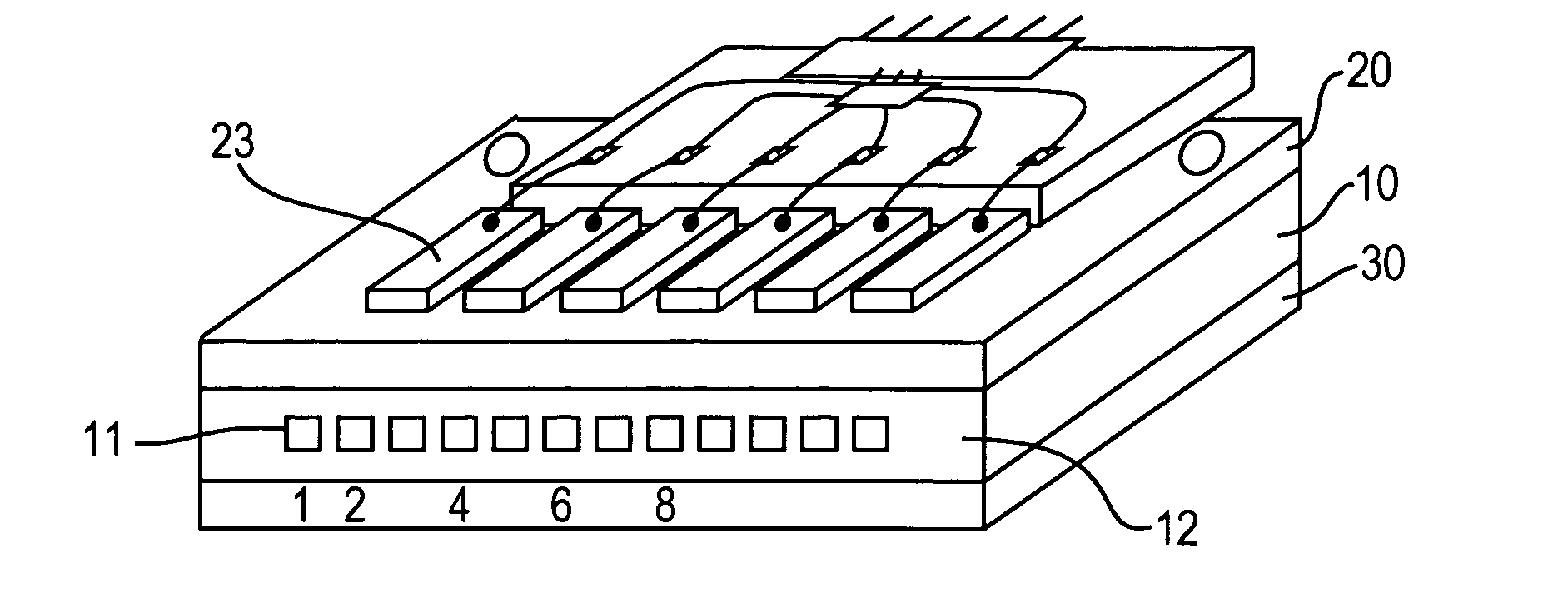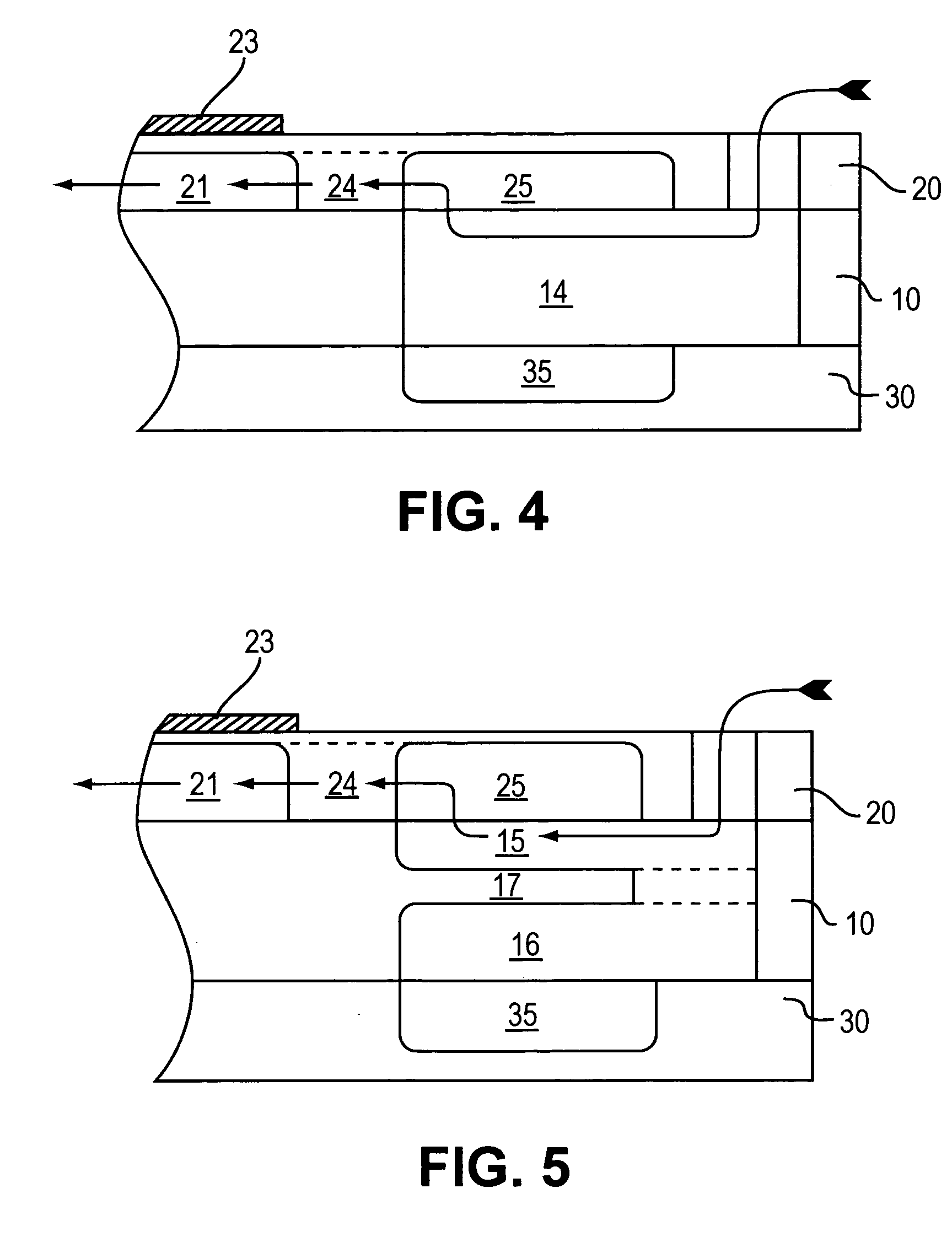Fluid jet print module
a printing module and fluid jet technology, applied in printing and other directions, can solve the problems of non-uniform or misdirected jets, differences in etch depths, and non-uniform edges
- Summary
- Abstract
- Description
- Claims
- Application Information
AI Technical Summary
Problems solved by technology
Method used
Image
Examples
example 1
[0070] The print module is composed of three structured components: a nozzle-carrying member (10) embedded between two chamber-carrying side members (20) and (30), as illustrated in FIGS. 1 to 7). The nozzle face (12) of the nozzle-carrying member (10) carries the nozzles (11), which are built in one row in the center of the nozzle-carrying member as shown in FIG. 1. The total number of nozzles is usually 2n, where n is an integer, but could be any other number as well.
[0071]FIGS. 2 and 3 show the fluid paths of the print module. The embedded nozzles (11) are connected to wells (13) in the nozzle-carrying member (10). The wells are structured on both sides of the nozzle-carrying member in an alternating and opposing pattern with respect to the nozzles, the even numbered nozzles form one nozzle group connecting to wells facing the top side chamber-carrying member (20), as shown in FIG. 2, and the odd numbered nozzles form a second nozzle group connecting to wells facing the bottom s...
example 2
[0082] The print module is composed of five components: a nozzle-carrying member (10) embedded between two chamber-carrying side members (20) and (30), each of the side members being composed of one chamber plate (20a) and (30a) respectively, and one capping plate (20b) and (30b) respectively, as illustrated in FIGS. 8 to 10.
[0083] The nozzles (11) are disposed in the face center of the nozzle-carrying member composed of a nozzle plate. The chambers of this device are etched through in chamber plates (20a) and (30a) in an alternating top-bottom pattern, respectively, whereas the diaphragms are provided two thin cover plates (20b) and (30b). The wells are structured on both sides of the nozzle-carrying member (10) in an alternating pattern with respect to the nozzles, the even numbered nozzles connecting to wells facing the top side member (20), as shown in FIG. 9, and the odd numbered nozzles connecting to wells facing the bottom side member (30), as shown in FIG. 10. The wells (13...
example 3
[0085] The print module is composed of three components: a nozzle- and chamber-carrying member (10) embedded between two side members (20) and (30), as illustrated in FIGS. 11 to 13. The entire channel structure of this device is built into a single plate (10). The nozzles (11) are centrally disposed in the nozzle face (12) of the center member. The chambers (21), (31), the wells (13) and the manifolds (15), (16) are build on both sides of the center member. The two side members (20) and (30) are cover plates providing the chamber diaphragms (22) and (32) and covering the manifolds (15) and (16), as shown in FIGS. 12 and 13, respectively. The fluid supply is provided by the two manifolds (15) and (16) separated from each other by a diaphragm (17). A fluid supply built out of one manifold (18), as depicted in FIG. 4, is also possible.
[0086] All other structural elements can be similar to those described in Example 1.
PUM
 Login to View More
Login to View More Abstract
Description
Claims
Application Information
 Login to View More
Login to View More - R&D
- Intellectual Property
- Life Sciences
- Materials
- Tech Scout
- Unparalleled Data Quality
- Higher Quality Content
- 60% Fewer Hallucinations
Browse by: Latest US Patents, China's latest patents, Technical Efficacy Thesaurus, Application Domain, Technology Topic, Popular Technical Reports.
© 2025 PatSnap. All rights reserved.Legal|Privacy policy|Modern Slavery Act Transparency Statement|Sitemap|About US| Contact US: help@patsnap.com



